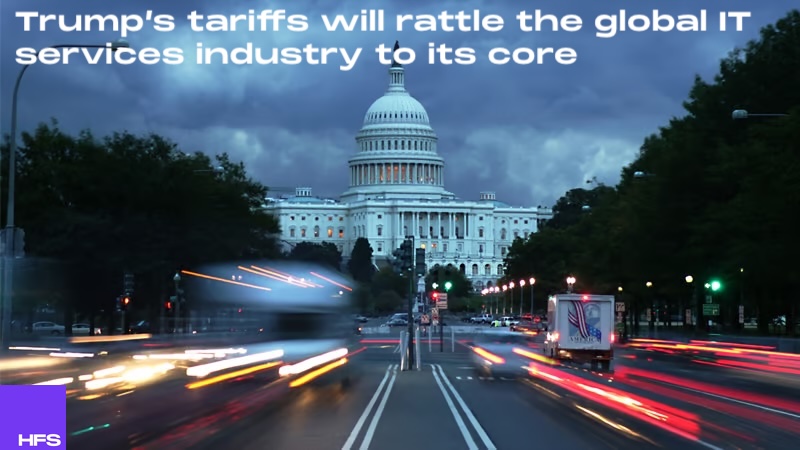
In the late 19th century, the US didn’t have an income tax and relied purely on tariff revenues. Now, the fate of the global economy lies with one “big beautiful bill” of income tax cuts, which President Trump believes will stimulate an economic surge for the country. Economics and analysts are highly skeptical that this will work.
At HFS, we see the very foundations of the IT services industry being rattled to the core. We had anticipated a hike in Indian exports to the US of 20% at worst, but this is even higher at 26%. Those recession odds are rising significantly now, and so with it is spending on IT services.
Goldman Sachs had put a 30% expectation of an economic recession before President Trump’s “Liberation Day” announcement of tariffs, which are far more severe than expected. These expectations are now over 50% and there will be a rapid domino impact on the IT services industry by immediately slowing down enterprise decision-making and increasing immediate focus on cost controls.
Expect lower innovation and more focus on AI to protect productivity
This new wave of Trump-era tariffs is aimed at foreign goods, but people everywhere will feel the aftershocks as they will constrain trade and create imbalance at a rate not witnessed since COVID-19 wrought havoc on global markets and societies.
Businesses in the US are shielded by this steep tariff war, which lowers the incentive to compete and innovate when there is less intense competition from abroad, which is undermining the US’s position as the world’s most innovative economy. The focus of a lot of US business is going to be squarely on cost reduction, and this will have a direct impact on the global IT and BPO services industry. This will result in a double whammy hit for the India-dependent service providers and consultancies as US firms will be incentivized to reshore services work back to the US and also to invest more heavily in AI to reduce reliance on support staff in areas like application development and business services.
What began as a populist policy move has become an anti-globalization movement that threatens to reshape the fabric of society and upend enterprise priorities across products, people, and profits.
Consumers say: “I won’t buy—it’s too expensive.”
Tariffing China at an effective 54% will raise the prices of goods. In 2024, the US imported $462.6 Billion in goods from China. The proposed increase will make many Chinese goods extremely expensive for the average customer, thus cooling consumer demand rapidly. China isn’t alone. Large trading partners like India, Vietnam, and the EU have also been hit with numbers that will force retaliation and restructuring of producing goods away from the US consumer.
With tariffs being applied globally, the US consumer – the world’s largest buyer of goods – will be forced to curtail spending at a rate not seen since COVID hit the markets in 2020. While there won’t be long lines for toilet paper, the travel, tourism, retail, and hospitality markets can be expected to see double-digit drops by Summer.
As the threat of unemployment looms, the new jobs promised by these tariffs to Americans are likely to never materialize as the knock-on of a double-digit drop in consumer spending, financial concerns, and a decline in government programs (typically used as stimulus but now hobbled by DOGE and Trump’s executive orders) are likely to accelerate a recession.
IT services and advisory firms will need to act quickly to address these consumer impacts by getting into war room footing with companies to seek out where manufacturing and imports that are tariffed less can be moved. There will be no free trade zones. This won’t withstand the changing economics of this new world order, but it may allow savvy firms to help their customers shore up contracts and services needed to deliver goods as they lean out their operations.
Enterprises respond: “We need to cut costs—fast.”
As consumer and business demand declines and margins tighten, businesses are expected to turn to cost-cutting levers.
While the Trump administration heralds these tariffs will force companies to reevaluate supply chains, repatriate manufacturing, and rethink cost structures to stay competitive – building a new multi-billion dollar manufacturing industry that can’t afford the steel and other building resource imports needed (thanks to high tariffs on neighbors like Canada) will make it these promised national investments impractical.
The expected outcomes will be a significant drop in consumer spending, double-digit inflation, and a likely doubling of unemployment. Companies facing this type of market will quickly cut consulting costs and technology investment costs and lean out supply chains to few products and goods – focusing on durable goods at lower margins.
Services firms will need to shore up contracts and reevaluate their IT and operations quickly—often viewed as back-office or non-core—become the first to become collateral damage as trade wars escalate.
IT Services: Collateral Damage in the Trade War
IT services are a mix of labour and technology arbitrage and have been adapting to a new economy post-COVID with more remote work, more AI, and an increasing dependence on the cloud and real-time data. Where COVID forced product and business model innovation, a global trade war will be about circling the wagons, constraining costs, and slowing product innovation as consumers and other businesses will no longer be looking to buy these new products.
The blow to IT services is indirect—but decisive:
- Digital nationalism intensifies: As political pressure to localize services gains ground, offshore delivery will face new skepticism. Despite not being directly tariffed, a view that a country’s workforce may benefit while US workers lose jobs won’t be popular. Expect companies to accelerate the use of data, automation, and AI to reduce any dependence on outsourced overseas jobs. GCCs may be heavily impacted.
- Margin pressure escalates: US firms will demand more value at lower cost. Services firms will be expected to absorb pricing pressure while delivering faster, smarter, cheaper outcomes. However, the longer the trade war lasts, the significant risk of many companies cutting IT services or not renewing contracts will increase. Large IT contracts will be cut drastically without a need to develop new products or services in a recession and with buyers needing less support for new products.
- Delivery shifts inward: The intent of tariffs is for US enterprises to undergo supply chain reengineering, onshore manufacturing, and create a closed-loop economy. However, the administration has created labor constraints that will make hiring workers, procuring materials to build new factories, and technology costs very expensive. Delivery will shift inward, but cost-cutting measures will be aggressive as many firms likely take a wait-and-see approach to how long these trade wars will continue.
- Agentic AI becomes the burning platform: Technology investment has been the means to find a new S-curve of productivity and competitive edge. However, as experience-led transformations (EX, CX) are deferred, AI risks, governance, and cybersecurity investments are expected to rise to the top. Yet, while these technologies might soften the blow – their cost models and the lack many companies have had in scaling these don’t mean these technologies are a slam dunk for services firms to bet their futures on.
- Delivery model realignment raises costs: As offshoring practices come under political and public scrutiny, firms will be forced to hire IT resources locally. This may require IT services firms to acquire U.S.-based firms or enter regional partnerships for increased nearshoring. But all these moves erode the economics of the global delivery model. And due to rising inflation will make any such investments very costly.
Bottom Line: The Trump administration has launched a series of tariffs on goods, triggering a chain reaction that will destabilize the global IT services industry and economies.
As firms are forced to determine how they’ll survey the impending economic uncertainty or decline, the IT services industry has no option but to double down on AI-led productivity gains and deep domain expertise to help clients weather the storm. The best case will be a harsh but brief storm, as we hope a sudden economic downturn can bounce back in late 2025. But this summer will likely be one of frozen spending, cost cutting, and restructuring.
IT services must get ahead of contracts and work with their customers to ease the burden of costs by offering terms that can adapt to the potential short and long-term scenarios. These may include:
- Where possible, IT services firms can help by proactively taking on business support teams and technology areas at more aggressive rates, targeting a near-term cut in services costs (and their profitability) in hopes that the rebound will make them more indispensable in the future.
- IT services firms will need to help companies refactor their ecosystems and make the procurement of goods from countries with better production costs than those being taxed the highest.
- Help companies switch from innovation and growth models to responsible cost management and workforce realignment.
The IT industry transformed itself to survive COVID. It must now do so again—this time, to outlast the era of tariff wars.
Posted in : Artificial Intelligence, Automation, GCCs, GenAI, IT Outsourcing / IT Services, Politics, Uncategorized






